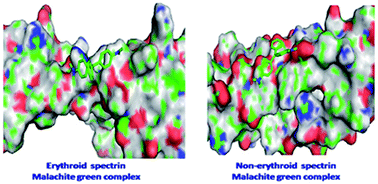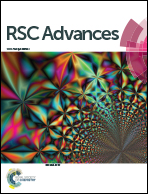Malachite green interacts with the membrane skeletal protein, spectrin†
Abstract
Malachite green (MG) is a triarylmethane dye that has been extensively used in chemotherapy, and photochemotherapy for cancer treatment. We have examined the molecular interaction of the membrane skeletal protein with MG using biophysical and spectroscopic methods under physiological conditions. Fluorescence (steady-state, synchronous and time-resolved) and circular dichroism (CD) spectroscopy techniques aided with molecular docking studies were performed to characterize the binding site(s), estimate the binding affinity and understand the molecular mechanism involved in the binding. MG caused quenching of the intrinsic tryptophan fluorescence of both forms of dimeric erythroid and tetrameric non-erythroid spectrin with a binding stoichiometry of 1 MG per spectrin both in their dimeric and tetrameric forms indicating the common self-associating domain of spectrin to provide the unique binding site for the hydrophobic dye. The thermodynamic parameters associated with the binding showed involvement of van der Waals interactions and strong hydrophobic forces without largely affecting the secondary structure of the proteins. The results of this work have also indicated the spectrin based cytoskeletal network as a chemotherapeutic target for cancer treatment like other cytoskeletal proteins.


 Please wait while we load your content...
Please wait while we load your content...